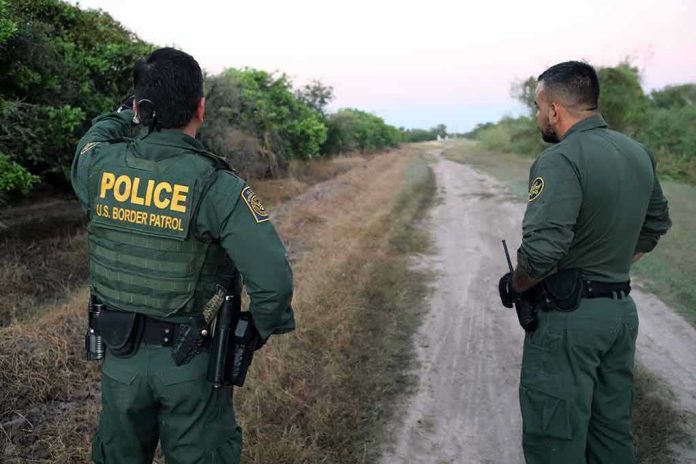
Criminal organizations exploited loopholes at the southern border by sedating children with marijuana gummies and using fake documents to bypass security—turning vulnerable minors into currency for profit.
Story Highlights
- Four suspects charged in El Paso for smuggling children using sedation and forged documents
- Children as young as five were drugged and falsely presented as the suspects’ own kids
- At least one child was hospitalized for marijuana poisoning during the operation
- Case exposes escalating brutality and sophistication in border child smuggling tactics
Criminal Smuggling Operation Used Children as Currency
Federal authorities uncovered a disturbing smuggling ring operating from Juárez, Mexico, to El Paso, Texas, where four adults—two Mexican nationals, a U.S. citizen, and a legal U.S. resident—conspired to traffic unaccompanied children. The accused posed as parents at official checkpoints, sedating minors aged 5 to 13 with marijuana-laced gummies to avoid detection. This operation, active from May to October 2024, involved falsified documents and nighttime crossings to minimize scrutiny. The criminal complaint revealed that children were treated as “currency,” highlighting a profit-driven scheme that placed young lives at risk for financial gain.
At least one victim was hospitalized for marijuana poisoning—an alarming escalation from prior cases that involved only over-the-counter sedatives. The suspects’ tactics demonstrate a calculated disregard for children’s health and safety, exploiting legal loopholes and border vulnerabilities. The core organizers, Susana and Daniel Guadian, allegedly recruited drivers and orchestrated the smuggling, while Dianne Guadian and Manuel Valenzuela managed transportation and payment logistics. Law enforcement described a transactional structure, with drivers paid per child and the operation spanning multiple jurisdictions, requiring cross-border coordination for arrests and ongoing extradition efforts.
Escalation of Tactics and Law Enforcement Response
This case spotlights how increased border enforcement has driven criminal organizations to adopt more sophisticated and dangerous methods. The use of marijuana gummies to sedate children marks a new low, building on previous trends of using fake documents and over-the-counter medications. According to statements from Homeland Security Investigations (HSI), these children were seen as nothing more than commodities—an indictment not only of the smugglers but of the systemic vulnerabilities that allow such schemes to flourish. Law enforcement agencies including HSI, ICE, and the Department of Justice have responded with intensified investigations, arrests, and pledges for aggressive prosecution, but the underlying humanitarian crisis persists as traffickers continually adapt their methods.
Federal officials have filed criminal complaints in the Western District of Texas, and the investigation remains ongoing, with further arrests and extraditions anticipated. The Department of Justice has stated unequivocally that those who profit from the suffering of vulnerable people will face comprehensive justice. The case has already resulted in increased scrutiny and law enforcement presence at border crossings, while also reigniting calls for stricter immigration enforcement to protect children and uphold the rule of law.
Impact on Border Security, Communities, and Policy
This high-profile case has immediate and far-reaching implications. In the short term, law enforcement’s disruption of the smuggling network has protected the affected children and heightened checkpoint vigilance. For border communities, the incident has intensified public concern and reinforced the need for robust law enforcement. Economically, the costs of such criminal activity include not only illicit profits for traffickers but also increased expenditures for healthcare and policing—highlighted by the hospitalization of drugged minors. Socially, the revelations have eroded trust in border security and underscored the ongoing threat posed by sophisticated trafficking operations. Politically, these events have fueled demands for stronger border controls and reforms, putting pressure on both U.S. and Mexican authorities to close loopholes that endanger vulnerable populations.
And this is what Democrats & corrupt, liberal judges are protecting for political reasons.
Four charged in Texas with smuggling children across border while posing as parents
Homeland Security Investigations says suspects used fake documents and sedated children at checkpoints— Dee Thompson (@PrissyDee99) September 19, 2025
In the broader context, this case exemplifies the evolving and brutal nature of human trafficking at the southern border—a challenge that persists despite changes in federal leadership. It also shows how criminal enterprises exploit gaps in enforcement, often placing children directly in harm’s way to serve their financial interests. Law enforcement and policy experts agree: while aggressive prosecution and inter-agency coordination are essential, enduring solutions will require vigilance, political will, and a commitment to upholding the values of individual liberty, child protection, and national sovereignty.
Sources:
Four charged in El Paso for smuggling children using THC-laced candy to sedate them
DHS: Making America Safe Again press releases
Four charged in conspiracy to smuggle children from Mexico
Western District of Texas nears 300 new immigration cases to start September














